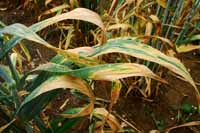Researchers close to cracking septoria code

Wheat varieties resistant to septoria are a step closer after researchers successfully identified how the fungus successfully evades the plant’s own defences.
In the UK, the disease is estimated to cost the industry a 5-15% reduction in grain yield each year. The disease kills cells in the plant’s leaves leaving large dead blotches which are unable to absorb energy from the sun.
“Mycosphaerella graminicola attacks wheat plants by stealth,” says Kim Hammond-Kosack of Rothamsted Research, who led the study in the UK. “There is normally a period of about a week between when a plant first becomes infected and when the characteristic blotches of the disease appear on its leaves. During this time it appears that the plant fails to recognise it has become infected and so is unable to activate its defences to fight back.”
By studying the fungus’ genome, Prof Hammond-Kosack hopes to further understand how the pathogen is able to go undetected and maybe reveal a weakness that researchers can exploit.
The genome sequence reveals that M graminicola has very few genes which produce enzymes able to break-down plant cell walls compared with other fungi which specialise in infecting plants. Plants often use the presence of the sugars and proteins released when a cell is broken down as cue for turning on their immune responses, so he thinks that the unusually low numbers of genes producing enzymes for breaking down plant cells may be crucial to the fungus’ stealth approach.
Collaborating with researchers at Wageningen University in The Netherlands, they have identified a protein in the fungus which is important in keeping it hidden.
Jason Rudd, who worked on the project at Rothamsted, adds: “We singled out a protein which helps keep the fungus camouflaged and protects it from the plant’s defences.
“When we generated a mutant strain of the fungus which didn’t contain the gene for this protein, the infected wheat plants produced strong immune responses and didn’t develop the characteristic leaf blotches. Our next step is to use these and similar findings to help farmers combat this disease out in the field in order to reduce wheat losses.”
The genome sequence was produced by an international consortium of researchers including scientists at Rothamsted Research in the UK, who were funded by BBSRC.

